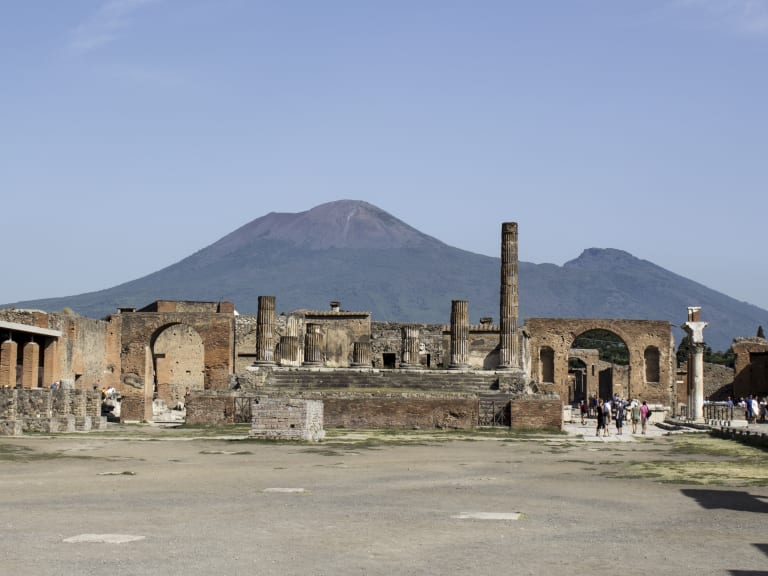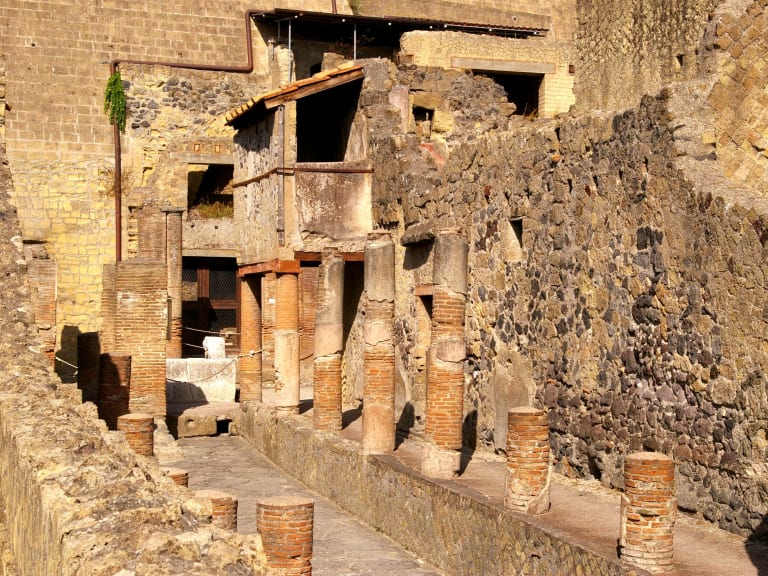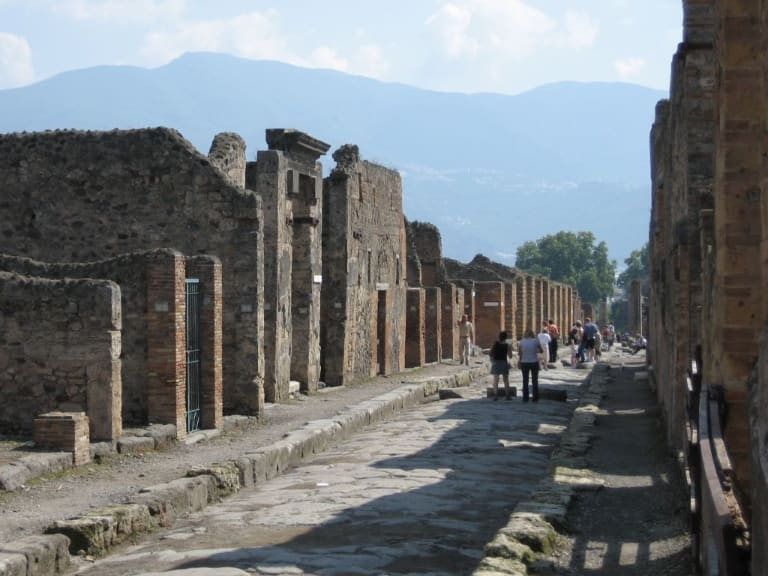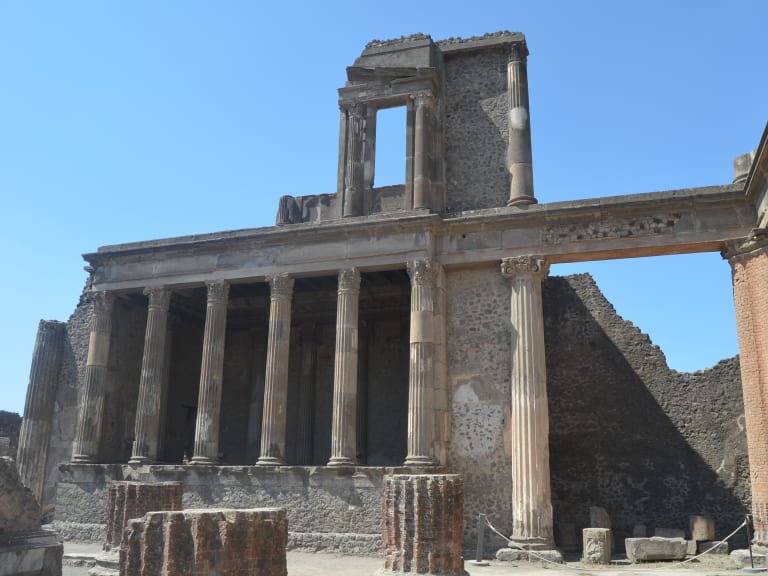More about: 6 Best Day Trips to Pompeii from Sorrento
There are many reasons to stay in Sorrento: it is close to Naples, it is a quiet town and well connected to the main attractions of the area. In the things to see and do in Sorrento, we can add an excursion to the archaeological site of Pompeii.
It is very extensive and is located a few kilometers from Sorrento. Moreover, Pompeii is very visited and it is important to know as many details as possible before booking an excursion.
1. Guided tour of Pompeii with skip the line admission

A ticket that avoids queues at the entrance is an incentive for any visit and Pompeii is no exception. You will enjoy the convenience of a shuttle bus that will drop you off just a few meters from the entrance. At every moment, an expert guide will lead you through the excavations.
Before being destroyed by the eruption of Vesuvius, Pompeii was an important agricultural and commercial center. Founded in the 8th century by the Osci, an Italic population, it was first conquered by the Greeks and then by the Etruscans and Samnites. Finally, the Romans took it over around the 3rd century BC.
Attracted by the beauty of the place, Roman aristocrats built summer residences and one of the most famous is the House of the Faun. It is huge and the best preserved mosaics have been transferred to the Archaeological Museum of Naples. Keep it in mind if you are looking for what to see and do in Naples.
Typically, these routes include attractions such as the Macellum (a monumental market where food was sold), the Stabian Baths and the House of Menander, a typical patrician residence. Its frescoes portray scenes from the Iliads and Odyssey while the lower area housed a private baths.
In order not to miss anything, these excursions often include an audio guide that will be useful not to miss any explanation.
- Duration: about 5 hours
- Price: from 70 €. For more information I recommend you to read the post that explains how much it costs to visit Pompeii.
- Recommended for those who want to visit Pompeii without complications or queues at the entrance.
2. Express tour of Pompeii

If you are staying two or three days in Sorrento and don't want to waste a whole day, this is your option. You will travel by train to Pompeii (the ticket is included) and get off a short distance from the archaeological park. During the journey you will have at your disposal a guide who will explain you how to get to the entrance.
This is the cheapest version but there is also a more complete version. In the latter case, the guide will accompany you among the houses and temples of Pompeii for 2 hours. In both cases, the tickets are skip the line tickets.
- Duration: about 2 hours
- Price: 40 € and 70 €.
- Recommended for those who have little time
3. Excursion to Pompeii and Vesuvius

This route allows you to see two landmarks of the region: the ruins of Pompeii, a UNESCO World Heritage Site and one of the few active volcanoes in Europe. A bus will pick you up from your hotel or a central location in Sorrento and take you to the famous site buried under the ashes of Vesuvius.
The excavations of Pompeii are the third most visited museum site in Italy. It is so large that one day is not enough to discover all its secrets; the guide will focus on the most famous monuments, such as the Forum and the Temple of Jupiter.
Outside the archaeological site you will also see the Sanctuary of the Madonna del Rosario, a majestic basilica inaugurated in 1901.
After the visit to Pompeii, the bus will take you to the foot of Vesuvius. The volcano is surrounded by a national park with a network of trails. An expert guide will accompany you to a safe point near the crater. From here you will enjoy a breathtaking view over Naples and its gulf.
- Duration: 8 hours or more
- Price: about 100 €.
- Recommended for those who want to discover the essentials of two iconic sites.
4. Pompeii and Vesuvius by boat

It is very similar to the previous option, but it is done by boat. It is a highly recommended option and not only for the experience and the scenery. Undoubtedly, an experience that could be among the best boat trips from Sorrento.
If you are staying in a hotel near Sorrento, you can request the pick-up service also in Massa Lubrense, Sant'Agnello, Piano di Sorrento and Meta. I recommend you to take a look at the details of the excursion.
You will travel from Piano di Sorrento to Castellammare di Stabia by boat and then take a bus to the archaeological park. After the visit there is a surprise: lunch in a local wine cellar. Volcanic eruptions have left an ideal land for the cultivation of vines and bottles of Falanghina, Aglianico and other exquisite varieties are produced here.
After lunch (which is included) it is time to climb the volcano. Once descended you will return to Castellammare di Stabia and take the boat to Sorrento.
- Duration: about 10 hours
- Price: about 160 €.
- Recommended for those who want an express but complete tour.
5. Day tour to Pompeii and Positano

Thanks to its privileged position, Sorrento is the perfect starting point for several excursions. A van will pick you up from your hotel or accommodation and in just under an hour you will arrive at the gateway to Pompeii.
Normally, the tour of the archaeological site lasts 2 hours or a little more. It is not very exhaustive, but it will give you the option to discover the history of this ancient city. When it was conquered by the Romans it quickly became a commercial center of great importance.
Wine and olive oil fueled **Pompeii'**s growth. Goods harvested at the foot of Vesuvius regularly reached southern France, Spain and also the Middle East. Unfortunately, prosperity came to an abrupt end in 79 AD when the volcano buried it under a thick layer of ash.
After a route among houses and public spaces embellished with statues and paintings, the minibus will take you to the historic town of Positano. You will have time to walk the streets of the old town and the promenade that connects the beaches of Spiaggia Grande and Fornillo.
It is a very suggestive walk that passes by the Saracen towers, watchtowers built to defend against pirate attacks. It is not for nothing that Positano is part of many excursions to the Amalfi Coast from Sorrento.
If you want to enjoy traditional cuisine without spending too much, you can go to La Tagliata ( Via Tagliata 32B), Da Vincenzo (Viale Pasitea 172) or Da Costantino (Via Corvo 95).
In case you want to go back home with a souvenir, you have many options to choose from. Positano is known for handmade sandals and the reference store is Safari (Via della Tartana 2). To go home with a bottle of limoncello or an assortment of local delicatessen, I recommend you to reach Valenti (Via Guglielmo Marconi 142).
In the afternoon, the minibus will accompany you back to Sorrento. Keep in mind that this is a long excursion and it is preferable to wear comfortable shoes. If you are traveling in summer, don't forget your hat either. There is also a skip the line ticket version.
- Duration: about 9 hours
- Price: between 90 € and 100 €.
- Recommended for those who are interested in a route that combines history with a visit to a typical Mediterranean village.
6. Tour to Pompeii and Herculaneum

Pompeii and Herculaneum are about 15 kilometers apart. Both are located at the foot of Vesuvius and yet they could not be more different. If Pompeii was an economically important city located inland, Herculaneum was a tiny town overlooking the sea.
When the eruption shook the area around the volcano, Pompeii was buried by about 8 meters of rocks and ashes while Herculaneum had a worse fate. Avalanches of mud and lava hid it some 25 meters below the surface. Therefore, the excavations are smaller: 4 hectares instead of 45.
At Herculaneum, what is most striking is the perfectly preserved urban fabric. From the entrance you can enjoy a very suggestive panoramic view. However, Pompeii's residences and public buildings are more elegant. The House of the Faun, the Temple of Apollo and the Stabian baths have no counterpart in Herculaneum.
These tours leave Sorrento in the morning - usually around 9:00 - and include an expert guide, skip-the-line ticket and a light lunch.
You will return to Sorrento around 17:30 and if you still have energy left, you can have a drink at the panoramic bar La Villa (Piazza Francesco Saverio Gargiulo).
- Duration: about 8 hours
- Price: about 150 €.
- Recommended for those who want to see both cities destroyed by the fury of the volcano.
What can't I miss in Pompeii?

The archaeological site is very large and the most important monuments must be clearly identified. The list below lists the most famous ones:
- House of the Faun, a huge residence that belonged to a prominent figure. It is one of the best preserved residences and owes its name to a statue of a dancing faun.
- Orto dei fuggiaschi, a series of plaster casts faithfully representing victims of the eruption. Before the fury of the volcano, a vineyard was located here.
- Amphitheater, the oldest performance building ever found. It is believed that in Pompeii there were more than 10 gladiatorial schools.
- Temple of Apollo, dedicated to the most worshipped divinity of ancient Pompeii. A bronze statue represents him as an archer. It housed a large number of statues that have been transferred to the Archaeological Museum of Naples.
- Lupanare, the old brothel of the city. On the walls you can see the writings left by prostitutes and their clients.
- Temple of Jupiter, a place of worship in the Forum, the main square. It was the most important of the city
To deepen your knowledge, I recommend you to read the article that explains what to see and what to do in Pompeii.
What do I need to bring?

The archaeological site of Pompeii occupies 66 hectares. There is a lot of walking and it is preferable to wear comfortable shoes.
If traveling in summer, be sure to bring a hat, water (I recommend a thermal water bottle) and sunscreen. There are trees and even a vineyard but many surfaces receive direct light for long hours of the day.
If you plan to visit in autumn or winter, it is preferable to put an umbrella or, even better, a raincoat in your backpack.
January is usually the coldest month but minimum temperatures rarely drop below 6º. To avoid unforeseen events, it is better to carry a hat and a scarf.
Is it worth taking a trip to Pompeii with children?

Yes, if they are old enough they are very likely to appreciate an ancient city with such a unique history. Attractions such as the Orto dei Fuggiaschi, the amphitheater with the gladiator gym or the Thermopolium - a kind of fast food of the time - will surely arouse their attention. For more information, I recommend you to read the post that explains how to visit Pompeii with children.
Is it worth eating at the restaurant in Pompeii?

The archaeological area has only one bar/restaurant. It is located near the Temple of Jupiter and is managed by Autogrill, a company specializing in catering for travelers. Its outlets are located on highways, train stations and airports throughout the country.
As you can imagine, it is a chain restaurant and if you don't have many pretensions, you can eat without spending too much. However, being the only option available, queues tend to form, especially if you visit the archaeological site in spring or summer.
For more ideas, I advise you to read the post that explains where to eat during a trip to Pompeii.
What is the best time to go to Pompeii?

Spring and autumn are the most recommended seasons. You will avoid the crowds and high temperatures of summer. Winter is usually not very crowded and can be ideal to visit the archaeological site without rushing.
For more information, I recommend you to read the post that explains in detail what is the best time to visit Pompeii.
Can I travel from Sorrento to Pompeii on my own?

Yes, you just need to take the Circumvesuviana railroad line. The station is located in Piazza Giovanni Battista de Curtis, in the heart of Sorrento. Get off at the Pompei - Villa dei Misteri stop. The main entrance is in Piazza Esedra, about a five minute walk away.
It is cheaper, but less comfortable and you will depend on public transportation schedules. Note that this line is usually very busy as it connects Sorrento to Naples. In the morning and after 18:00, the trains are crowded.
What are the must-see towns near Pompeii?

The most famous towns and villages have already been mentioned in the article. However, there are other "minor" destinations worth discovering:
- Castellammare di Stabia. With so many beautiful neighbors, most of the time it goes unnoticed. The town has a nice promenade and an old town reminiscent of the center of Naples. On the heights, a medieval castle dominates Castellammare. It is practically next to Pompeii
- Gragnano, the city of pasta. Spaghetti, fusilli, maccheroni and other varieties of the homonymous brand are produced here. If you feel like it, you can visit the museum free of charge. All you have to do is send an e-mail in advance to reserve your place. You can find the address on the official website
- Vico Equense, the gateway to the Sorrento peninsula. Its icon is the gothic/baroque church of Santa Maria Annunziata built on a spur overlooking the sea.
- Corbara, a village on the heights known for the corbarino, a tomato shaped like a small lamp.










